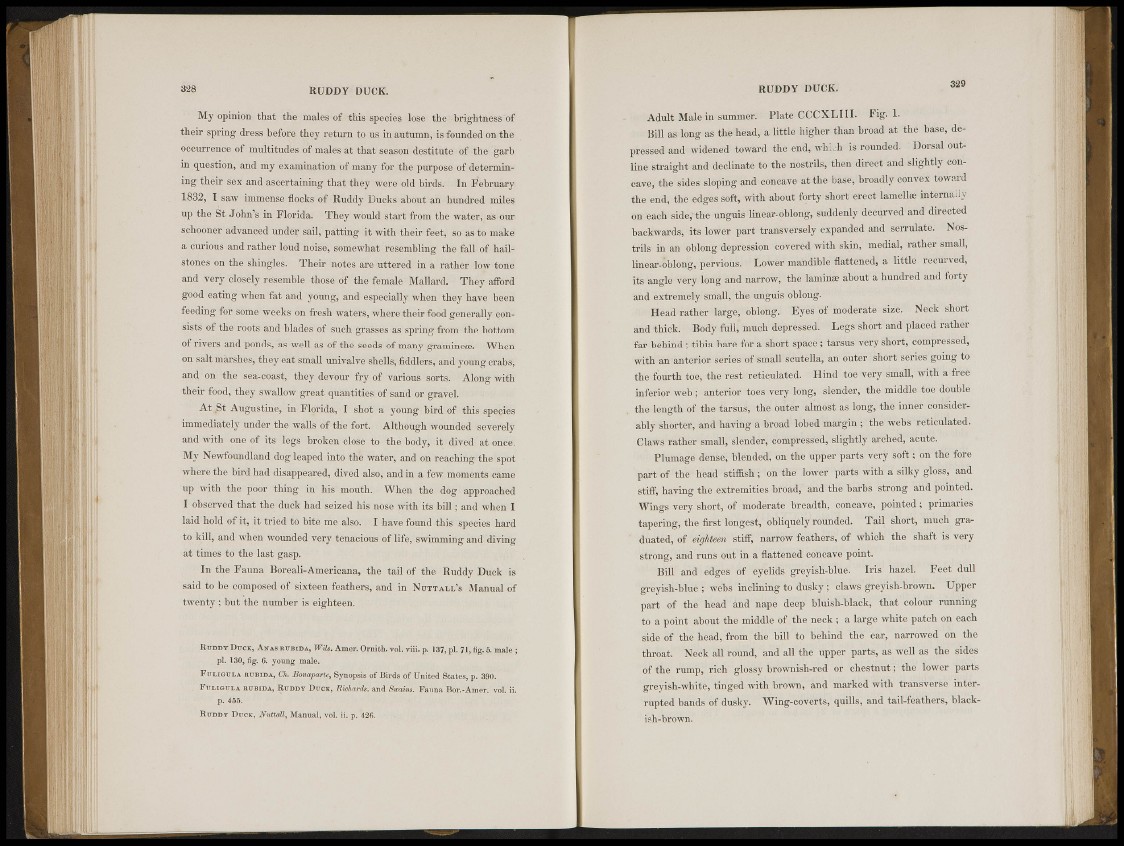
328 R O D D Y DUCK.
My opinion that the mali« of'this species lose the brightness of
tteir spring dress before they return to us in auiumn,¿¿found«) ori the
occurrence óf: multitudes of-males: at that'season destitute of the garb
l a question, and my examination of many for t i e purpose ^determining
their sex and ascertaining that they were old birds.,: In February
1832, I saw immense Hocilis of Ruddy Ducks about an hundred miles
up the S t John's in Florida. They would start fri« the water, as our
schooner advanced under sail, patting it with their feot, so as to make
a curious and rather loud noise, soiricwhnt resembling tho fall-of tòri»
stones'on tlie shingles." Their notes aro uttered in a ratlin- low tone
and very closely resemble those of tlio feniale Mallard. They afford
good eating when fat and young, and especially wli.m they have been
feeding for some weeks on'.frosh waters, whore thoir-fàclà generally consist*
of the roots and blades of such grasses as spring from thè bottom,
of rivers and ponds, as well as of the seeds of many uraniini-fe. When
on; s a l marshes, they eat small univalve shells, fiddler*, and young crabs,
and on the sèS-cbasi, thov devour fry of various .'softs. Along with
their food, they swallow great quantities of .sand or gravel. .
At^St Angustino, »Florida, I shot a young bird iif- thi.-species
immediately under the walls of the fort. Although wounded' -severely
and with on® of it's'ilcgs broken dose to the body, it dived at once.
My Newfoundland dog leaped into thè water, and on reaching the spot
where the bird had disappeared, div-cd-also. and in a few moments came
up with the poor thing in his mouth. When the dog approached
I observed that the duck had seized his nose with its hill ; and when I
laid hold of it, it tried to bite mo' also. ; X hive found this species hard
to kill, and when wounded very tenacious óf life, swimming and diving
at times' to the last gasp.
Iti the Fauna Iteroali-Anierieana, the tail of' the Ruddy Duck is
said to bo composed of sixteen feathers, and in Nuttall's Manual of
twenty ; hut the number is eighteen. :
Krnny JIcck, Ax as rabida, Wils. Amer. Ornitli. vol. viii. p. 137,pi. 71, fig. 5. male ;
pi, 130, fig. 6. young male.
Ki:t.kìui.a rubida, Ck. H-inajnine^ Synopsis of Birds of United States,W390.
. Fri.ioi.-LA rubida, Ruddy Dttcx, Wcbivle. and Sv)aim. Famm Bor.-Amer. vol. i:.
•'" p. 455.
H I'D lì V TJtjck, NuttaU-, Manual, vol. iì. p. *t2ii. i.,
R U D D Y DUCK. 329
Adult Male in summer. Plate OCCXLHI . Fig. 1.
Bill ils long: as the head, a little higher than broad at the hase, depressed
ami widen«! toward #<?< end, » i f ehi is rounded. Dorsal ¡ratline
straight and decimate « the nostrils, then direct and slightly con-
„avo, the sides .sloping and concave at the base, broadly convex toward
the end, the edges soft, with about forty Short erect lamelloe internally
on each side,Mho unguis linear-oblong, suddenly dccurved and directed
backwards, its lower part transversely expanded and serrulate. Nostrils
in an oblong depression covered with skim, medial, rather small,
linear-oblong, perviousit^llSwer mamliblc Battened, a little recurved,
its angle very long aid narrow, the lamina- about a hundred and forty
and extremely small, the unguis oblong.
Head rather large, oblong. Tfifi® of moderate size.' Neck'-'short
and thick. Body full,' much depressed: Legs short and placed rather
far behind ; tibia bare for a short space ; tarsus very short, compressed,
with an anterior series'of-smut', scutella, an.'outer short serins going to
the fourth toe, the rest reticulated. Hind toe very small, with a free
inferior web ; anterior toes very long, slender, the middle toe double
the length of the tarsù^fJe:' outer almost as long, the inner considerably
shorter, and having a broad lobed margin ; the webs reticulated.
Claws rather small, slendcf, compressed, slightly arched, acute.
Plumage dense, blended, un the upper parts very soft ; on the fore
part of the head 'istiffish ; on the lower parts with a silky gloss,: and
stiff, having the extremities broad, and the barbs strong and pointed.
Wings very short, of moderate breadth, concave, pointed : primaries
tapering, the i r s t longest, obliquely rounded. Tail short, muAjgrar
' duated, of eighteen stiff, narrow leathers, of which the shaft is very
strong, and runs out in a flattened concâve point.
Bill and edges of eyelids greyistt-biW! * Iris hazel. Feet dull
greyish-hliK^wÀs inclining io dusky ; claws greyish-brown. Upper
part of the head and nape deep Wuisl)-i)lack, that colour running
to a point about the middle of .the neck ; a large white patch on each
side of the head, from the bill to behind the ear, narrowed on the
throat.' Ncc.klSl round, and all the upper parts, as well as the sides
of the rump, rich glossy brownish-rod or chestnut ; the lower parts
greyish-white, tinged with brown, and marked with transverse interrupted
bands of dusky. Wing-coverts, quills, and tail-feathers, blackish
brown.